Japanese Sword Identification through the Discovery of Markings and Stamps
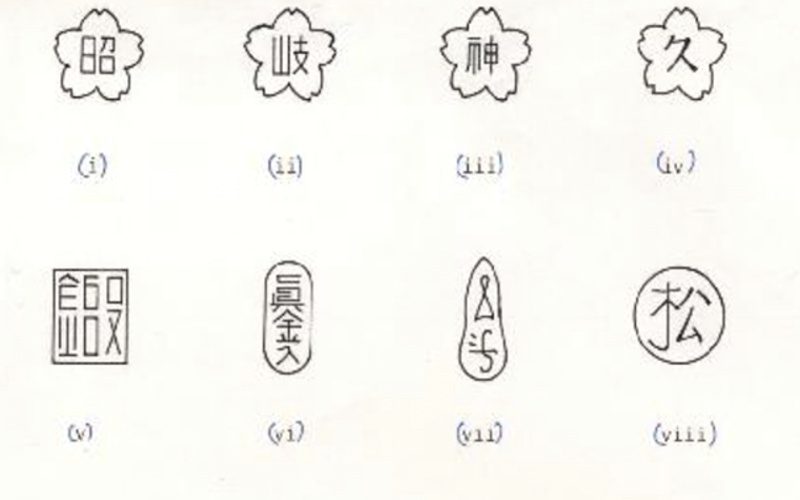
What’s in this article?
Throughout history, markings on blades served as a means of the maker’s identification. Throughout Japanese history, a well-known emblem – the chrysanthemum – is found on blades that date back as far as the 1600s. Personal marks known as kakihan or kao have even been seen on blades as old as the 1300s, all hand carved. Markings in the form of stamps were only seen during the industrial age around the 1800s when Japan adopted Western military structures.
This article is a summary of a document provided by Mr. Bruce Pennington who was kind enough to share the information he had compiled over the years with the help of his friends. Mr. Pennington graduated from the US Air Force Academy and was a pilot for the Air Force and later for American Airlines. Retired from both, he collects and studies WWII Japanese swords. He enjoys the challenge of digging into unknown facts about the swords and has made a few discoveries.
Sword Encyclopedia would also like to acknowledge Mr. Chris Bowen who also contacted us regarding the error we made in one of our articles about the Japanese swords used in World war 2 concerning the sword stamps.
How Japanese Sword Stamps Came to Be
There is little to no official information about the use of stamps on Japanese military blades. Tang stamps were thought to be introduced as swordsmiths and collectors were unable to distinguish between traditionally made swords and non-traditional swords such as gendaito.
It has long been believed that the government passed a law requiring non-traditional swords to be marked where non-traditional swords were to be marked with a tang stamp. This system was not fully implemented until 1940 and led to a profusion of different stamps.
Although no official document could be found regarding this regulation, a Police Chief memo that was found showed that the Ministry of Interior were primarily concerned about poor quality showato and gimei.
Showa Stamp

Based on the current information available, Showa stamps are thought to be the first on the scene with the earliest stamped blade available dating back to 1935. Since the showa-to was being tested for quality, it seems natural that the “Sho” stamp was designed for them.
However, it is important to note that since half of all Seki stamped blades were undated, there is a possibility that the Seki stamp is just as old or older than the Showa stamp. It is not known whether this stamp was used on both gendaito and showato.
Seki Stamp

Seki stamps are seen in two sizes: 5mm (large) and 3mm (small). The earliest Seki stamp seen so far dates back to 1940. This means that both Showa and Seki stamped blades are available between 1940 to 1942.
Like the Showa stamp, the Seki stamp was commercial and used by the Seki Cutlery Manufacturer’s Association. In 1943, the large Seki stamp rapidly tapered off and the small Seki stamp began. During this time, most dated stamped blades that year bore the “Na” of the Nagoya Army Arsenal.
Gifu-in-sakura Stamp
1943 also marks the appearance of the Gifu-in-sakura stamp which is possibly the stamp adopted by the Seki Cutlery Manufacturers Association in response to the use of the Seki stamp by Nagoya Inspectors.
Star Stamp

Both private swordsmiths and sword companies were commissioned to forge swords where the nakago was marked with the swordsmith’s mei and a simple Star Stamp that shows it has passed Army material inspection.
This means that the star stamp certifies that the steel used to forge the blade was provided by the army. This stamp is also found on other army products and steels. Currently, there is documented proof that star stamped blades are folded tamahagane nihonto.
Complementary Stamps

Extraordinary Stamps

Japanese Army Sword Inspection Marks as of 1943
| Inspection Mark | Name | Notes |
|---|---|---|
| 東 – TŌ | 東京第一陸軍造兵廠監督課 Tōkyō 1st Army Arsenal Supervisory Section | Officer Sword NCO/Enlisted Sword |
| キ – Ki | 第二製造所 2nd Factory of Tōkyō 1st Army Arsenal | NCO/Enlisted Sword |
| 名 – Na | 名古屋陸軍造兵廠監督課 Nagoya Army Arsenal Supervisory Section | Officer Sword NCO/Enlisted Sword |
| 関 – Seki | 名古屋陸軍造兵廠関監督班 Seki Supervisory Unit of Nagoya Army Arsenal | Officer Sword NCO/Enlisted Sword |
| 阪 – Saka | 大阪陸軍造兵廠監督課 Ōsaka Army Arsenal Supervisory Section | Officer Sword |
| 小 – Ko | 小倉陸軍造兵廠監督課 Kokura Army Arsenal Supervisory Section | Officer Sword NCO/Enlisted Sword |
| 山 – Yama | 小倉陸軍造兵廠松山出張所 Matsuyama Branch Office of Kokura Army Arsenal | Officer Sword |
| 江 – E | 小倉陸軍造兵廠松江監督班 \ Matsue Supervisory Unit of Kokura Army Arsenal | Officer Sword |
| 熊 – Kuma | 小倉陸軍造兵廠熊本監督班 Kumamoto Supervisory Unit of Kokura Army Arsenal | Officer Sword |
| ホ – HO | 小倉陸軍造兵廠第一製造所 1st Factory of Kokura Army Arsenal | Officer Sword NCO/Enlisted Sword |
| セ – SE | 小倉陸軍造兵廠第二製造所 2nd Factory of Kokura Army Arsenal | Officer Sword |
| 仁 – JIN | 仁川陸軍造兵廠監督課 Jinsen Army Arsenal Supervisory Section | NCO/Enlisted Sword |
| ヘ – HE | 仁川陸軍造兵廠平城製造所 Heijō Factory of Jinsen Army Arsenal | Officer Sword NCO/Enlisted Sword |
| 南 – NAN | 南滿陸軍造兵廠監督課 Nan-Man Army Arsenal Supervisory Section | Officer Sword |
| 連 – REN | 南滿陸軍造兵廠大連監督班 Dairen Supervisory Unit of Nan-Man Army Arsenal | Officer Sword |
| 社 – SHA | 各民間工場 Each civilian/private factory | NCO/Enlisted Sword |
Armored Factory Arsenal Trademarks


Stamps on Japanese Military Blades & Fittings
Compiled from various sources by Richard Fuller, readers should note that the info in this section was published in 1995 and therefore, some descriptions may be outdated.
| Logo / Stamp & Name | Description |
|---|---|
 ‘Shō’ (abbreviation for ‘Shōwa’) stamp | Post 1926 military inspection and/or acceptance stamp used until around 1941. Very common. |
 ‘Gi’ stamp | Probably an abbreviation of ‘Gifu prefecture’. Possibly the Gifu Swords Co-Operative (or Union). |
 ‘Kami’ (meaning ‘God’) stamp | Significance unknown. Found only on shin-guntō tsuba. Very rare. |
 ‘Hisa’ stamp | Significance unknown. Found on a naval dagger crossguard. |
 ‘Tan’ or ‘Kitau’ stamp | Literally ‘to forge’ or ‘forged’. Very scarce. |
 Shin gane iru’ stamp | Literally ‘genuine steel put in’ i.e. genuine inserted steel. Very rare. |
 ‘Five measures’ stamp | Literally Go (5)-To (measure of capacity. (1 To = 3.97 Imperial gallons). Significance unknown. Very rare. |
 ‘Matsu’ stamp | Associated with tang issue or batch numbers. Significance unknown. Appears limited to blades found in 1944 pattern army mounts. |
 ‘Seki’ stamp | Military inspection and/or acceptance stamp for blades made at Seki in Nōshū (Mino) province. Prevalent after December 1941. Very common. |
 ‘Star’ stamp | Military inspection and acceptance stamp. Believed to be associated with good quality hand forged ‘mill steel’ blades but not those made with traditional tamahagane. Generally post 1942 but more often found in 1944 pattern army mounts. Rare. (Note: Also used as a ‘materials’ stamp on military firearms). |
 ‘Tai’ stamp | Appears on late war blades made by smiths associated with the Izumo Seikō (Izumo Steel Works Co.) in Shimane prefecture which was located close to the Izumo Taisha (i.e. Izumo Grand Shrine). 1945. |
 ‘Wa’ stamp | Probably indicates manufacture in an occupied area, most likely by a collaborating force. Found on poor quality rolled or hammered blades. |
 | Probably a naval inspection and/or acceptance stamp. Found on naval parade sabres and dagger guards. Possibly associated with the Toyokawa Naval Arsenal. |
 Unidentified | Found on a naval dagger crossguard. |
 Unidentified | Found on a 1903 Forestry Officials dagger crossguard. |
 ‘Kikusui’ (chrysanthemum on water) | When found stamped on the tang above a smith’s signature it indicates manufacture at the Navy controlled Minatogawa Shrine forge from 1940. Good quality hand forged blades. Rare. (Note: Also adopted as a kamikaze motif in 1944 but does not imply this usage when found on the blade). |
 Large unidentified stamp found above a signature | Probably a retailer’s logo. Rare. |
 Unidentified stamp | Found on the reverse of signed but undated tangs. Probably the logo of a private manufacturer or retailer. Rare. |
 Logo of the South Manchurian Railway Company | Seems to be associated with blades dated 1938. Scarce. |
 Logo of the North China Joint Stock Transportation Company | Found on specially made shin-guntō fittings and also on signed sword tangs. Rare. |
 Small unidentified W stamp noted only on blades dated 1943 | Possibly the Chigusa Factory or Nagoya Arsenal. |
 Seal stamp which has been found on the reverse of an undated Shōwa Period blade | Probably a retailer’s trade mark. It reads NIHON (Japan) TORA (tiger) GO (a suffix meaning ‘title’ or ‘item’. Possibly meaning ‘an item by Tiger of Japan’. |
 Stamp found on military sword and dagger fittings | Logo of the Suya Company of Tokyo. They appear to be a private company that provided military fittings. |
 Unidentified | Reported on naval dagger crossguards and also a Fire Commander’s dagger. |
 Small unidentified tang stamp on an unsigned shōwa period blade | See xxxiii below. |
 Small ‘I’ stamp | The cursive form of 伊 meaning ‘that one’. Found below the Toyokawa Naval Arsenal stamp xxxvi below and above an inscription reading INAMI 以奈波 (presumably a name which incorporates the same ‘I’ character). |
 ‘Saka’ stamp | Signifying the Osaka Rikugun Zōheisho (Osaka Army Arsenal). |
 ‘Ren’ stamp | Signifying the Dairen Railway Factory in Manchuria which made ‘Mantetsu’ blades. Post 1937. |
 Trademark of Wakasei Seisaku Jo | Trademark of a company located in Tokyo that made fittings for army and navy swords. |
 Unidentified | ‘Tō’ kanji meaning sword. Found only on a shin-guntō kabuto-gane (pommel fitting). |
 Stamp of the Gunso Kabushiki Gaisha Company of Tokyo | Army and navy sword fittings |
 Unidentified small stamp | Reported only once on a kōtō period blade under the habaki. This had been shortened and was in shira-saya (wooden keeper fittings). Perhaps the logo of the company that shortened it. |
 ‘Ni’ stamp meaning ‘two’ | Believed to indicate a second class military weapon when found with a manufacturer’s mark or arsenal stamp. Noted in conjunction with xxxv below on a c1945 pattern Army NCO’s sword and also with xxv above. |
 Gold paper quality control label | Found on a shōwa period lacquered scabbard. It confirms inspection by the Seki Cutlery Industrial Society. Probably early 1940s. Very scarce. |
 ‘He’ stamp | Inspection mark of the Heigo factory of the Jinsen (Inchon) Arsenal, Korea. Noted only in conjunction with xxxiii above but may have another significance since the Korean manufacture of swords is, so far, unconfirmed. |
 Toyokawa Naval Arsenal inspection stamp | Aichi Prefecture, Japan. |
 Unidentified | Possibly ‘Yoru’ meaning ‘depend on’. Found under a Toyokawa Naval Arsenal stamp xxxvi above. |
 Small ‘Na’ inspection stamp of the Nagoya Arsenal | / |
 ‘Matsuyama’ stamp | Used by the Guntō Seisakujō which made military sword fittings. Stylized version of the two kanji for Matsuyama 松山 which is the owner’s name. |
 ‘Nan’ stamp | Possibly the Kokoburi Factory of Chuo Kogyo Ltd. Part of the Nambu Rifle Manufacturing Company. |
 Tenshozan Company stamp | Located in Kamakura Prefecture, Japan. Appears to have made kai-guntō only |
 Unidentified | Possibly ‘Jo’ meaning the best, high class. |
 Unidentified | / |
 ‘To’ stamp meaning ‘sword’ | Used by the Nōshū Nihonto Tanrenjō (Mino province Sword Forging Company) where Seki is located. |
| Unusual and rare hot stamp reading ‘Hyakuren’ | Translates as “well-tempered”. Noted only once on a signed showa period blade. Very rare. |
 Kikumon Stamp | Known examples date as early as the 17th century. Predominantly believed to indicate that the smith was on retainer by the Shogunate. The meaning of the “ichi” or “一” is unknown but could indicate the smith’s work was representing the ichimongi school. |
Buddhist Stamps on Japanese Swords
There are various Buddhist stamps found on Japanese blades. These include the flaming jewel, the god of fortune and fertility Daikokuten, Kuniyasu, Masayasu, and more. Here are some other stamps seen:
Sanko-tsuki-ken or Sanko-zuka-ken

Possibly a Buddhist symbol to chase away the devil, this stamp is thought to be a stylized ken, a straight sword with a handle that reflects the incarnation of the deity Fudo Myoo. The lotus petals may represent Buddha. The stamp on the left image was found on a Tadahiroblade while the right on a Kanetoshiblade.
The “Five Measures” Stamp

The kanji inscribed on both blades in the images above are written in Tensho script as depicted below:

Koshirae Stamps
The term “Koshirae” refers to the mountings of a Japanese sword. Besides stamps on the blade itself, some Japanese swords also have stamps on the mountings itself. While some are known to be arsenal or private company marks, many of these koshirae stamps remain unidentified.
Here is some information on company logos which Mr. Pennington has shared with the permission of Mr. Bowen based on advertisements placed in war era sword publications. Found on stickers on war era iai-to and gunto koshirae, some of these logos belonged to sword shops that only sold gunto, but did not manufacture them themselves.
| Logo / Stamp & Name | Description |
|---|---|
 Shirakiya Guntobu | Located in Tokyo. They provided koshirae for gunto, and claimed in their ad that their swords would absolutely beat the English and American forces. |
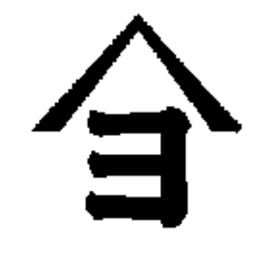 Nakano Shoten | Located in Tokyo. This company was owned by Mr. Nakano. In addition to Tokyo, the company had shops in China. The company provided a full range of koshirae. |
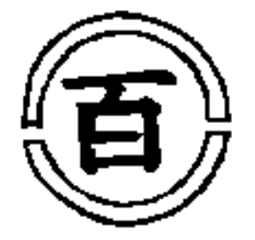 Seki Hyaku Tan Sha Token Sei Saku Jo | This company was located in Seki city. They offered a complete line of services, including old blades, newly made gunto, polishing, and koshirae. They also made gunto. |
 Suya Sho Ten | Located in Tokyo. This company was used by the Suikosha, or Navy Supply Center. The company made gunto koshirae. The owner of the company was Mr. Shimada. This company started back in the Meiji era and had a long history of making koshirae, including those for members of the Imperial family and many high ranking officers and diplomats. |
 Kamikodo Tokenya | This shop was located in Tokyo. They offered kodogu, polishing, and provided gunto koshirae. The shop was run by Okuda Masami, a member of the well-known Butoku Kai and a kendo sensei. |
 | This mark was used by a shop in Aizu Wakamatsu owned by Mr. Ozawa. The shop offered gunto koshirae, shirasaya, and togi services. [Owaza Keiji sword polishing and fittings shop; George Trotter] |
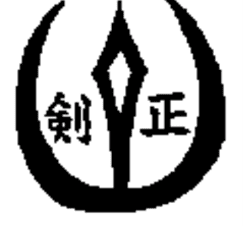 Shokendo Guntoya | Located in Yokosuka, Kanagawa Prefecture. Offered blades, army and navy gunto, polishing, shirasaya, tsukamaki, repairs, etc. Owned by Mr. Yamaguchi. |
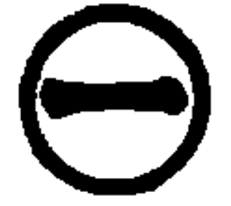 Tsunemitsu Kosaku Jo | Located in Kofu city, Yamanashi Prefecture. They manufactured koshirae, and had a long history of making sword related items. |
 Gunto Sei Saku Jo | Located in Tokyo. The company was owned by Mr. Matsuyama. This firm made koshirae for both army and navy, as well as koshirae for police, diplomatic, and ceremonial uses. |
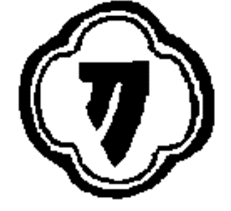 Nihonto Tanrenjo | Located in Seki city. The company was owned by Mr. Hara. The company made both traditionally made swords and sunobe gunto. They also manufactured army and navy koshirae, offered repairing and polishing, and shirasaya. |
 Sugimoto Tokenya | Located in Tokyo. Provided gunto, various sword related services. They mention in their ad that they carry an alumite gunto saya koshirae. |
 Wakasei Seisaku Jo | Located in Tokyo. They made army and navy koshirae. They won a Minister of the Navy Award in the koshiraesection of the Shinsaku Tenrankai. |
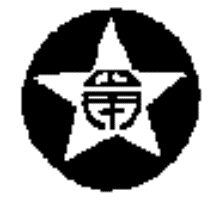 Yamamoto Guntoya | Located in Tokyo. This company provided gunto for the war effort. |
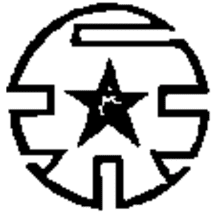 Shoheikan Gunso Kabushiki Gaisha | This company made army and navy koshirae. They also advertise a wood saya gunto koshirae. The company was located in Tokyo and owned by Mr. Saito. |
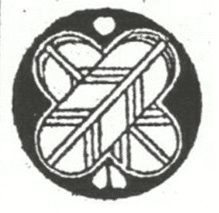 Nakayama Token Ten | This shop was located in Tokyo. They sold guntoand sword related items. |
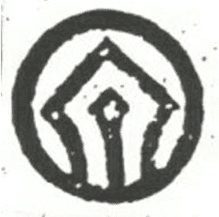 Fujishiro Sho Ten | This is the logo of the well-known Fujishiro family which offered polishing, sold both old swords as well as gunto, and published a variety of sword related literature. |
 Kuramoto Toishi Ten | This shop was located in Kyoto and supplied togishiand craftsmen with stones for polishing. |
 Omura Token Kogeisha | This company was located in Hiroshima. They used both the logos. They sold gunto and offered sword related services. |
Other Markings Seen on Japanese Swords
Besides sword stamps, there are also other markings that have been observed. They include:
Modified Roman Numerals

These can be found on both shingunto and kaigunto fittings.
Patent Stamps

Dots

These punch dots are often found on nakago, both on the jiri and mune. They range from single to multiple dots and can be found on blades of multiple smiths as well as mumei blades. Further research is needed to determine the reasons for use and if they are from a particular area / prefecture.
Foil Labels

While not stamps, these were mentioned in Fuller & Gregory’s chart and are sometimes brought up by collectors. The only observed labels all come from “The Seki Cutlery Manufacturer’s Society, Seki Gifuken Japan ”. One label has been found with only Japanese, but all others are written in both English and Japanese.
A summary of Mr. Pennington’s compiled information throughout the years, readers can find a more in-depth explanation along with more images in the pdf document he has kindly shared. Since this article was only made possible through the sharing of information from various parties, Sword Encyclopedia would once again like to credit those who made this possible: Bruce Pennington, Chris Bowen, Richard Fuller, Jim Dawson, Ohmura-San, Richard Stein, Nick Komiya, and Thomas (Kiipu), Trystan Huang, Chris Schmucker, Stephen Christensen, Neil Freeland, Steve Opie, Ernst Matak, John Mankey, George Trotter, Malcolm Cox, Ray Singer, Steve Miller, Moriyama Koichi, Uwe Sacklowski, Piers D., and more!




